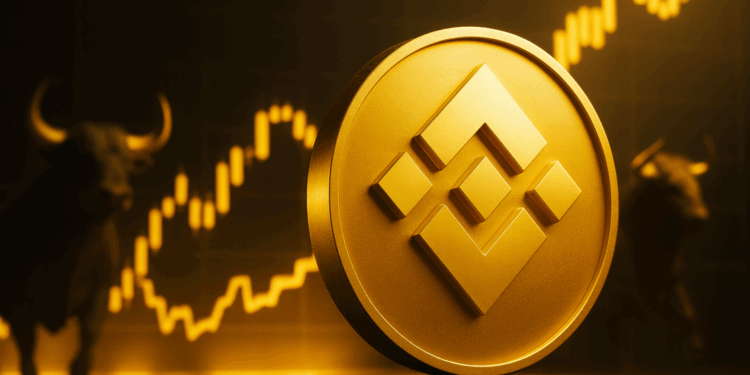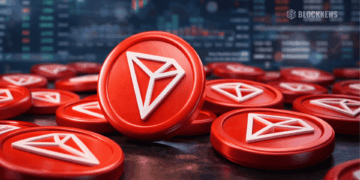- BNB evolved from a Binance trading discount token into a core asset powering DeFi, NFTs, gaming, payments, and governance.
- BNB Chain delivers high scalability, ultra-low fees, and cross-chain interoperability, with major upgrades improving speed and security.
- Future plans target sub-150ms confirmations, 20,000+ TPS, and privacy features, aiming to rival centralized exchange performance.
BNB, once just a humble utility token created to shave a few cents off trading fees, has morphed into the backbone of an expansive ecosystem that supports decentralized applications, financial infrastructure, and real-world commerce. With constant development, a powerful burn mechanism, and deep-rooted utility across multiple verticals, BNB is a foundational layer in the next generation of digital finance. So, let us take a closer look at how BNB went from ICO curiosity to becoming one of the most influential crypto projects in the industry.
What Is BNB?
BNB, short for Binance Coin, was introduced in 2017 during an Initial Coin Offering (ICO) to fund the launch of the Binance exchange. It began life as an ERC-20 token on Ethereum but soon migrated to Binance’s proprietary blockchain—initially Binance Chain and then expanding to what is now known as BNB Chain.
Originally issued with a max supply of 200 million tokens, BNB was created as a utility token to reduce trading fees on Binance. But over the years, the token has grown into something much bigger. BNB now serves as gas for the BNB Smart Chain, powers decentralized apps, supports NFT creation, and acts as a currency for everything from gaming and entertainment to travel and online retail. It is a coin with a serious role, underpinned by powerful fundamentals and growing utility.
How Does It Work?
BNB operates on a unified blockchain system known simply as the BNB Chain, centered around the BNB Smart Chain. This chain is fully compatible with the Ethereum Virtual Machine (EVM), allowing developers to use familiar Ethereum tools to build smart contracts and decentralized applications (dApps).
Notably, the network runs on a unique consensus mechanism called Proof of Staked Authority (PoSA), which blends delegated proof of stake and proof of authority. This model allows validators to secure the network by staking BNB while also holding a public reputation to maintain trust. It supports faster transaction finality and lower costs—critical features in today’s competitive blockchain environment.
Overall, BNB serves multiple roles within this ecosystem — it is the native currency for paying transaction fees (gas), staking for network validation, participating in governance, and powering a broad spectrum of decentralized finance (DeFi) applications and services. This streamlined architecture allows BNB Chain to support a high-performance, scalable, and interoperable environment essential for the expanding decentralized economy.
What Problems Does It Solve?
BNB Chain addresses some of the most persistent challenges in the blockchain industry—scalability, high transaction fees, slow network speeds, and limited real-world utility. While many chains claim to solve these issues, BNB has actually delivered on performance through a combination of technical innovation, economic incentives, and a robust developer ecosystem. This includes:
Scalability
With thousands of transactions per second and sub-second finality, BNB Chain tackles the congestion issues that have plagued other blockchains. Whether it is DeFi, gaming, or NFTs, the network maintains seamless performance at scale.
Affordability
Gas fees on BNB Chain hover around 0.01 USD—making it one of the most cost-effective chains in the market. This low barrier enables broader participation and micro-transactions that are simply not viable on high-fee chains like Ethereum.
Interoperability
Through its multichain architecture and bridging infrastructure, BNB enables fluid movement of assets and applications across chains. It plays well with others—Ethereum-compatible tooling, cross-chain swaps, and wrapped assets all operate efficiently in the ecosystem.
Decentralized Storage
With the introduction of BNB Greenfield, users gain full control over their data. This decentralized storage network offers a permissionless alternative to traditional cloud storage—faster uploads, encrypted control, and the ability to build truly decentralized applications without relying on centralized hosting.
Smart Contract Efficiency
BNB Chain continues to push innovation through upgrades like Super Instructions and Application Sidechains. These advancements streamline contract execution, reduce on-chain bloat, and allow tailored environments for large-scale dApps.
Utility and Offerings
With offerings that cut across trading, DeFi, NFTs, payments, and decentralized storage, BNB serves as both fuel and currency for a rapidly growing blockchain economy. Some key offerings include:
Trading and Transaction Fees
Users holding BNB receive up to 25 percent discounts on Binance spot trading fees and 10 percent on futures. With over 40 million BNB used to pay fees on more than 127 billion trades, this utility is far from obsolete. It remains one of the most cost-effective ways to engage with Binance’s trading products.
Staking and Governance
BNB is staked by validators and delegators to secure the chain, while also serving as a voting token for on-chain governance. Holders can participate in proposal approvals, validator elections, and changes to protocol parameters. This decentralized decision-making gives the community influence over how the network evolves.
Launchpad and Launchpool Access
BNB unlocks access to exclusive project launches. On Binance Launchpad, users commit BNB to subscribe to early-stage token offerings. On Launchpool, users stake BNB and stablecoins to earn new project tokens. These platforms have become breeding grounds for some of the most successful blockchain projects in recent years.
Decentralized Finance (DeFi)
BNB is the beating heart of BNB Chain DeFi. It serves as collateral in lending protocols like Venus, fuels liquidity pools on PancakeSwap, and operates as the primary gas token across thousands of dApps. It also underpins bridges and multichain liquidity systems, helping assets move between ecosystems without friction.
NFTs and Gaming
NFT marketplaces on BNB Chain and third-party platforms use BNB as the currency for creation, sale, and transfer of digital assets. In gaming, BNB is used for in-game purchases, tokenized economies, and reward systems—powering everything from metaverse land to competitive play.
Payments and E-commerce
BNB moves beyond exchanges through services like Binance Pay and Binance Card, allowing users to spend it across hundreds of global merchants. From booking travel to paying freelancers and purchasing subscriptions, BNB acts as a functional currency bridging Web3 with everyday commerce.
Ecosystem Highlights
From strategic collaborations to explosive on-chain growth, the BNB ecosystem is a dynamic force shaping the broader blockchain landscape. Its expanding influence is driven by aggressive innovation, market reach, and a clear focus on mainstream adoption. This includes:
Strategic Partnerships
BNB Chain continues to strike partnerships across sectors—gaming studios, payment providers, institutional platforms, and Web2 tech companies. These alliances have fueled integrations with traditional finance systems, boosted NFT adoption, and enabled BNB to be used in real-world scenarios far beyond its origins.
Developer Ecosystem
BNB Chain ranks among the top in active developer count, with thousands of smart contracts deployed and maintained. Hackathons, grants, and accelerator programs have helped onboard builders globally, with strong focus on sectors like DeFi, GameFi, AI, and decentralized identity.
Institutional Integration
Several custody platforms, exchanges, and fintech firms now offer BNB-based products, including derivatives, staking services, and index funds. This signals growing confidence in BNB’s staying power among large financial entities, many of which have begun leveraging BNB Chain for infrastructure deployments and tokenization pilots.
Daily Active Users and TVL
BNB Chain consistently sees millions of daily transactions and a high volume of active addresses. It is one of the leading networks by Total Value Locked (TVL), driven by popular protocols like PancakeSwap, Venus, and LayerZero integrations. This demonstrates strong user engagement and liquidity across sectors.
Cross-Chain Connectivity
BNB’s presence on multichain bridges and wrapped token platforms extends its reach beyond its own chain. BNB is commonly used in cross-chain swaps and appears as a wrapped asset on other networks, enhancing its liquidity profile and making it a preferred medium of exchange for interoperable applications.
Roadmap and Plans Ahead
In early 2025, BNB Chain set out to improve speed, reduce costs, and eliminate unfair trading practices. Through the Lorentz and Maxwell hardforks, block time dropped to 0.75 seconds, finality to under 2 seconds, and malicious MEV was reduced by 95%. These upgrades enabled the network to handle over 12 million daily transactions, with record highs nearing 18 million, all while keeping gas fees around $0.01—making BNB Chain one of the fastest and most affordable blockchains in use.
The second half of 2025 focuses on scaling. A tenfold increase in block gas limit will enable up to 5,000 DEX swaps per second. To support this growth, BNB Chain is launching a new Rust-based execution client optimized for speed and efficiency. Smart contract performance is also being enhanced through features like Super Instructions and StateDB improvements, designed to streamline complex operations and cut down on redundant data access.
Looking ahead to 2026 and beyond, BNB Chain is preparing for a next-generation architecture. Plans include sub-150ms transaction confirmation, support for over 20,000 transactions per second, and native privacy for transfers and smart contract calls. Combined with user-friendly features like multi-signature wallets and simplified authentication, the goal is clear – deliver centralized exchange performance with full Web3 control and accessibility.
Final Thoughts
In conclusion, BNB began its life as a glorified loyalty program. It now commands a multiverse of protocols, utilities, and applications spanning finance, gaming, governance, identity, and data ownership. So, as BNB Chain moves into its next phase of speed, scale, and sovereignty, it will be interesting to see how far it can push the boundaries of mainstream blockchain adoption.














